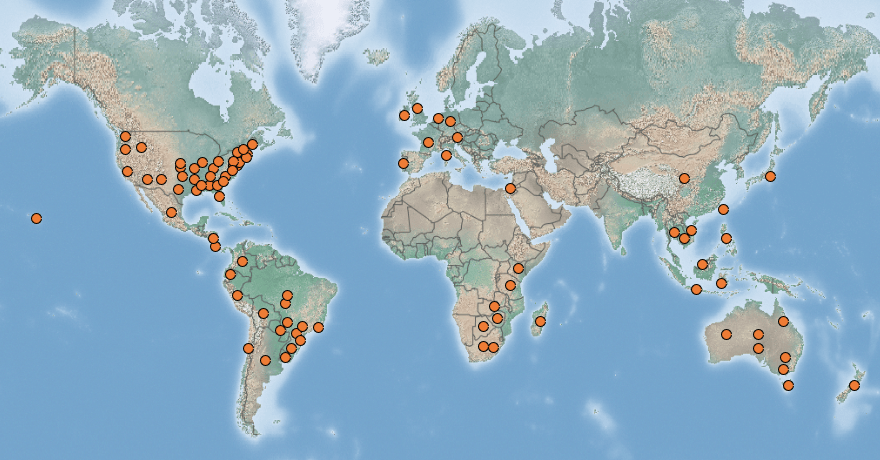 |
Parrot’s-feather | Status LU: established. 1st record: LU & ITW ~1990. |
 |
Brasilien-Dausendblat | Status Eur.: established. 1st record: unkn. IAS of EU concern (2016). |
 |
Myriophylle du Brésil | RA: ISEIA: B1, Watch List. Harmonia+: 0,51. |
 |
Brasilianisches Tausendblatt | Wikipedia: |
 |
Parelvederkruid | Back to the list of neophytes |
Contents
Report the species
→ Report Myriophyllum aquaticum to the National Museum of Natural History.
Brief description
 Myriophyllum aquaticum (Vell.) Verdc. is an invasive submerged/emergent aquatic weed characteristic of sub-tropical to warm-temperate regions, but found as far north as the UK. The species thrives in well-lit ponds, ditches, canals and slow-running streams. It is most often found in eutrophic water bodies and is able to grow as a terrestrial plant when ponds dry out, making it well-adapted to medium water level fluctuations (Branquart et al. 2013).
Myriophyllum aquaticum (Vell.) Verdc. is an invasive submerged/emergent aquatic weed characteristic of sub-tropical to warm-temperate regions, but found as far north as the UK. The species thrives in well-lit ponds, ditches, canals and slow-running streams. It is most often found in eutrophic water bodies and is able to grow as a terrestrial plant when ponds dry out, making it well-adapted to medium water level fluctuations (Branquart et al. 2013).
IAS of Union concern
In 2016, Myriophyllum aquaticum (Vell.) Verdc. was added to the list of invasive alien species of Union concern (Anonymous 2016) which implies that member states shall take all necessary steps to prevent it’s unintentional introduction or spread.
Status and distribution in Luxembourg
Records of Myriophyllum aquaticum (Vell.) Verdc. in Luxembourg. Data source: Recorder-Lux, iNaturalist & GBIF, 2025-07-07.
Myriophyllum aquaticum (Vell.) Verdc. was first documented by Roland Proess in his Herbarium in June 2000 at Freschewisen near Roeser, a dead branch stream of the Alzette river. According to Proess, this large population in a pond has existed for at least 10 years (Colling & Krippel 2003: 16). Parrot’s-feather’s first record for Luxembourg can thus approximately be dated to ~1990. Another observation by Mikka Mootz on 1 April 2019 in a nearby pond in Houwisen confirms the presence of the species in the same area.
In 2019, extensive patches were discovered in the Thilleweier pond in a forest environment (Dudelange). A third site was detected in 2020 near Saeul (Krippel et al. 2020: 42).
This eastern North American species is very rare, subspontaneous or naturalised [in the Luxembourg environment]. In Europe, only female flowers have been reported, which are necessarily sterile in the absence of male flowers. Apparently, however, the plants observed in the wild are only known in the vegetative state. This species became naturalised here during the 1990s. Its expansion seems to be continuing (Lambinon & Verloove 2012: 422-423).
Risk assessment
ISEIA protocol
B1 (2+2+3+3) = Watch List (Ries et al. 2013: 18).
Harmonia+ protocol
Overall risk score 0,51 = (Overall Invasion score 0,68 x Overall Impact score 0,75) (Ries et al. 2020).
 Invasion
Invasion0,75

 Impact
Impact0,51

 Risk
RiskWorldwide distribution
Bibliography
- Anonymous, 2016. Commission implementing regulation (EU) 2016/1141 of 13 July 2016 adopting a list of invasive alien species of Union concern pursuant to Regulation (EU) No 1143/2014 of the European Parliament and of the Council. Official Journal of the European Union L 189: 4-5.
- Branquart, E., L. Triest, S. Vanderhoeven, W. Van Landuyt, F. Van Rossum & F. Verloove, 2013. Harmonia database: Myriophyllum aquaticum (Vell.) Verdc. Harmonia version 1.2, Belgian Forum on Invasive Species. URL: http://ias.biodiversity.be [accessed on 2019-10-14]
- CABI, 2019. Myriophyllum aquaticum. In: Invasive Species Compendium. Wallingford, UK: CAB International. URL: www.cabi.org/isc [accessed 2020-03-02]
- Colling, G. & Y. Krippel, 2003. Notes floristiques. Observations faites au Luxembourg (2000-2001). Bull. Soc. Nat. luxemb. 103: 3-23. [PDF 342 KB]
- Krippel, Y., T. Helminger & G. Colling, 2020. Notes floristiques. Observations faites au Luxembourg (2018-2019). Bulletin Soc. Nat. luxemb. 122 : 29-55. [PDF 132 KB]
- Lambinon J. & F. Verloove, 2012. Nouvelle flore de la Belgique, du grand-duché de Luxembourg, du Nord de la France et des régions voisines. Sixième édition. Avec la collaboration de L. Delvosalle, B. Toussaint, D. Geerinck, I. Hoste, F. Van Rossum, B. Cornier, R. Schumacker, A. Vanderpoorten et H. Vannerom. Jardin botanique national de Belgique, Meise. CXXXIX + 1195 pp. ISBN : 9789072619884.
- MNHNL, 2000-. Myriophyllum aquaticum (Vell.) Verdc. in Recorder-Lux, database on the natural heritage of the Grand Duchy of Luxembourg. Musée national d’histoire naturelle, Luxembourg. URL: https://mdata.mnhn.lu [Accessed 2019-10-14]
- MNHNL, iNaturalist & GBIF, 2020. Myriophyllum aquaticum (Vell.) Verdc. in MNHNL-mdata, online portal combining species observation from Recorder-Lux, iNaturalist and GBIF. National Museum of Natural History, Luxembourg. URL: https://mdata.mnhn.lu [Accessed 2019-10-14]
- Oly, M., 2022. Kartierung invasiver gebietsfremder Wasserpflanzen im Großherzotum Luxemburg, Untersuchungen zur Verbreitung von invasiven gebietsfremden Wasserpflanzen in einer beispielhaften Auswahl an Stillgewässern, Musée national d’histoire naturelle, Luxembourg. 117 pp.
- Ries, C. & Y. Krippel, 2021. First records of 56 invasive alien vascular plants in Luxembourg. Bulletin de la Société des naturalistes luxembourgeois 123: 115-127. [PDF 241 KB]
- Ries, C., Y. Krippel & M. Pfeiffenschneider, 2020. Risk assessment after the Harmonia+ protocol of invasive alien vascular plant species in Luxembourg. Bull. Soc. Nat. luxemb. 122: 197-205. [PDF 132 KB]
- Ries, C., Y. Krippel, M. Pfeiffenschneider & S. Schneider, 2013. Environmental impact assessment and black, watch and alert list classification after the ISEIA Protocol of non-native vascular plant species in Luxembourg. Bull. Soc. Nat. luxemb. 114: 15-21. [PDF 652 KB]
Suggested citation of this webpage
Ries, C., M. Pfeiffenschneider & Y. Krippel (Eds.), 2025. Myriophyllum aquaticum (Vell.) Verdc. In: neobiota.lu - Invasive Alien Species in Luxembourg. National Museum of Natural History, Luxembourg. URL: https://neobiota.lu/myriophyllum-aquaticum/ [Accessed 2025-07-07].
Page content last updated on 2023-08-18. Last proofread by Caroline Grounds on 2019-11-20.


